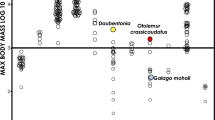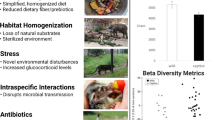Abstract
We gathered data on the amount, composition, and rate of ingestion of foods and soils by the provisioned Japanese macaques (Macaca fuscata fuscata) at Arashiyama, Japan. Behavioral observations spanned one year on 8 adult females, using focal animal sampling. We analyzed a subsample of their foods for nutritional and toxic secondary compound content. We also analyzed soils eaten by the macaques for several physical-chemical properties and tested their adsorption affinity to tannins and alkaloids. Geophagy occurred at a high rate of 2.97 g/indiv./day with an elevated frequency in the afternoon. About two-thirds of their foods (by fresh weight) were provisioned items, which are extremely rich in proteins and soluble carbohydrates. The soils that they ingested were generally poor in mineral elements, the bio-availability of which was low. The soils had a high adsorption capacity for plant alkaloids but were poorly absorptive for tannins. They were rich in clay minerals of proven buffering capacity. Geophagy at Arashiyama may improve the health of macaques via buffering gastric upset. We discuss the results from the viewpoint of several hypotheses on geophagy.
Similar content being viewed by others
REFERENCES
Allen, S. E. (1989). Analysis of vegetation and other organic materials. In Allen S. E. (ed.) Chemical Analysis of Ecological Materials, Blackwell Press, Oxford, pp. 46-61.
Altmann, J. (1974). Observational study of behaviour: Sampling methods. Behaviour 49: 227-267.
Aufreiter, S., Hancock, R. G. V., Mahaney, W. C., Stambolic-Robb, A., and Sanmugadas, K. (1997). Geochemistry and mineralogy of soils eaten by humans. Intern. J. Food Science and Nutr. 48: 293-305.
Berreshein, K., Mattern-Klossen, N., and Wilmers, M. (1991). A standard form of spectra for quantitative ESCA analysis. Fresenius J. Anal. Chem. 341: 121-124.
Clark, T. W. (1979). Food adaptations of a transplanted Japanese macaque troop (Arashiyama West) Primates 20(3): 399-410.
Davies, A. G., and Baillie, I. C. (1988). Soil-eating by red leaf monkeys (Presbytis rubicunda) in Sabah, Northern Borneo. Biotropica 20(3): 252-258.
Day, P. E. (1965). Particle fractionation and particle size analysis In Black, C. A (ed.) Methods of Soil Analysis. Madison, Wisc., Amer. Soc. of Agronomy. Pp: 545-567.
Fedigan, L. M., and Asquith, J. P. (1991). The Monkeys of Arashiyama: Thirty five years of Research in Japan and the West. State University of New York Press.
Fraser, D., and Hristienko, H. (1981). Activity of Moose and White tailed deer at mineral springs. Can. J. Zool. 59: 1991–2000.
Freeland, W. J., and Janzen, D. H. (1974). Strategies in the herbivory by mammals: The role of plant secondary compounds. Amer. Naturalist. 108: 269–289.
Ganzhorn, J. U. (1987). Soil consumption of two groups of semi-free ranging lemurs (Lemur catta and Lemur fulvus) Ethology 74: 146-154.
Gilardi, J. D., Duffey, S. S., Munn, C. A., and Tell, L. A. (1999). Biochemical functions of geophagy in parrots: Detoxification of dietary toxins and cytoprotective effects. J. Chem. Ecol. 25(4): 897-922.
Hancock, R. G. V. (1978). Some aspects of the analysis of ancient artifacts by neutron activation. J.Intern. Inst. Conservation-Canadian Group 3: 21-27.
Hancock, R. G. V. (1984). Onthe source of clay used for Cologne Roman pottery. Archaeometry 26: 210-217.
Harborne, J. B., and Turner, B. L. (1984). Plant Chemosystematics. Academic Press, London.
Hebert, D., and Cowan, I. M. (1971). Natural licks as part of the ecology of mountain goat. Can. J. Zool. 49: 605-610.
Heymann, E. W., and Hartmann, G. (1991). Geophagy in Moustached Tamarins Saguinux mystax (Platyrrhini: Callitrichidae) at the Rio Blanco, Peruvian Amazonia Primates 32(4): 533-537.
Hladik, C. M. (1977a). Acomparative study of feeding strategies of two sympatric species of leaf monkeys: Presbystis senex and Presbytis entellus. In Primate Ecology: Studies of Feeding and Ranging Behaviour of Lemurs, Monkeys and Apes. Clutton-Brock (ed.) Academic Press Inc. London. pp: 324-353.
Hladik, C. M. (1977b). Chimpazees of Gabon and Chimpanzees of Gombe: Some comparative data on the diet. In Primate Ecology: Studies of Feeding and Ranging Behaviour of Lemurs, Monkeys and Apes. Clutton-Brock (ed.) Academic Press Inc. London. pp: 481-501.
Huffman, M. A. (1991). History of Arashiyama Japanese macaques in Kyoto, Japan. In The Macaques of Arashiyama: Thirty-five years of study in Japan and West. Fedigan, L. M. and Asquith, P. (eds.). SUNNY Press, New York. pp: 21-53.
Huffman. (1984). Plant foods and foraging behavior in Japanese monkeys of Arashiyama: Seasonal variation. Arashiyama Shizen Kenkyujo Hokoku, 3: 55-65 (Japanese).
Inoue, M. (1987). Soil eating of Japanese macaques (Macaca fuscata) at Arashiyama Kyoto. Primate Res. 3: 1103-111 (in Japanese, abstract in English).
Iwamoto, T. (1974). A Bioeconomic study on a provisioned troop of Japanese monkeys (Macaca fuscata fuscata) at Koshima Islet, Miyazaki. Primates. 15(2-3): 241-262.
Iwamoto, T. (1988). Food and energetics of provisioned wild Japanese macaques (Macaca fuscata) In Ecology and Behaviour of Food-Enhanced Primate Groups. Fa, J. E. and Southwick, C. H. (eds.) New York. Alan R. Liss. pp: 74-79.
Iwamoto, T. (1982). Food and nutritional condition of free ranging Japanese monkeys in Koshima Islet during winter. Primates 23(2): 153-170.
Jackson, M. L. (1956). Soil Chemical Analysis-Advanced Course, published by the author, Dept. of Soil Science, Univ. of Wisconsin, Madison, Wisc.
Julliot, C., and Sabatier, D. (1993). Diet of Red Howler Monkey (Alouatta seniculus) in French Guiana. Int. J. Primatol. 14(4): 527-551.
Klaus, G., and Schmid, B. (1998). Geophagy at mineral licks and mammal ecology: A review. Mammalia 62(4): 481-497.
Knezevich, M. (1998). Geophagy as a therapeutic mediator of endoparasitism in a free ranging group of Rhesus Macaques (Macaca mulatta). Amer. J. Primatol. 44: 71-82.
Kraulen, D. A. (1985). Lick use by large herbivores: A review of benefits and banes of soil consumption. Mammal Rev. 15(3): 107-123.
Mahaney, W. C. (1990). Ice on the Equator, Wm Caxton Press Ltd., Ellison Bay, Wisconsin, 386 pp.
Mahaney, W. C., Aufreiter, S., and Hancock, R. G. V. (1995a). Mountain Gorilla geophagy: A possible seasonal behaviour for dealing with effects of dietary changes. Int. J. Primatol. 16(3): 475-488.
Mahaney, W. C., Stambolic, A., Knezevich, M., Hancock, R. G. V., Aurifreiter, S., Sanmugadas, K., Kessler, M. J., and Grynpas, M. D. (1995b). Geophagy amongst Rhesus macaques on Cayo Santiago, Puerto Rico. Primates 36(3): 323-333.
Mahaney, W. C., Hancock, R. G. V., Aufreiter, S., and Huffman, M. A. (1996). Geochemistry and clay mineralogy of termite mound soil and the role of geophagy in the chimpanzee of Mahale Mountains, Tanzania. Primates 37(2): 121-134.
Mahaney, W. C., Hancock, R. G. V., and Inoue, M. (1993). Geochemistry and clay mineralogy of soils eaten by Japanese macaques. Primates 34(1): 85-91.
Mahaney, W. C., Watts, D. P., and Hancock, R. G. V. (1990). Geophagy by Mountain Gorillas (Gorilla gorilla beringei) in the Virunga Mountains, Rwanda. Primates 31(1): 113-120.
Marriott, B. M. (1988). Time budgets of rhesus monkeys (Macaca mulatta) in forest habitat in Nepal and on Cayo Santiago In Ecology and Behaviour of Food-Enhanced Primate Groups. Fa, J. E. and Southwick, C. H. (eds.). Alan R. Lis. New York. pp: 125-149.
Marriott, B., Sultana, C., and Roemer, J. R. (1993a). Does soil serve as a condicament, a detoxicant or a mineral supplement for rhesus monkeys? A comparison of results from Cayo Santiago and Nepal. Amer. J. Primatol. 30: 332 (abstract only).
Marriot, B., Pearson, E., Roemer, J., and Woodbury, R. O. (1993b). Selection of dietary supplements by free-ranging Rhesus monkeys on Cayo Santiago. Amer. J. Primatol. 30: 332 (abstract only).
Moe, R. S. (1993). Mineral content and wildlife use of soil licks in South-western Nepal. Can. J. Zool. 71: 933-936.
Mole, S., and Waterman, P. G. (1987). A critical analysis of techniques for measuring tannins in ecological studies. I. Techniques for chemically defining tannins. Oecologia 72: 137-147.
Mori, A. (1979). Analysis of population changes by measurement of body weight in theKoshima troop of Japanese monkeys. Primates 20: 371-397.
Muller, H. K., Ahl, C., and Hartmann,G. (1997). Geophagy in masked Titi monkeys (Callicebus personatus melanochir) in Brazil. Primates 38(1): 69-77.
Nahm, K. H. (1992). Practical Guide to Feed, Fotage and Water Analysis (Accurate Analysis with Minimal Equipment). Yoo. Seoul.
Norconk, M. A., Wertis, C., and Kinzey, G.W. (1997). Seed predation by monkeys and macaws in Eastern Venezuela: Preliminary findings. Primates 38(2): 177-184.
Oates, J. F. (1978). Water-plant and soil consumption by colobus monkeys (Colobus guereza): A relationship with minerals and toxins in the diet? Biotropica 10(4): 241-253.
Robertson, J. B., and Van Soest, P. J. (1980). The detergent system of analysis and its application to human foods. In James, W. P. T., and Theander, O. (eds.), The Analysis of Dietary Fiber in Food, Marcel Dekker, New York and Basel, pp. 123-158.
Soumah, G., and Yokota, Y. (1991). Female rank and feeding strategies in a free ranging provisioned troop of Japanese macaques. Folia Primatologica 57: 191-200.
Sultana, C. J., and Marriott, B. M. (1982). Geophagy and related behaviour of rhesus monkeys (Macaca mulatta ) on Cayo Santiago, Puerto Rico. Int. J. Primatol. 3: 338 (abstract only).
Wheeler, W. E. (1980). Gastrointestinal tract pH environment and the influence of buffering materials on the performance of ruminants. J. Animal Sci. 51(1): 224-235.
Wiley, S. A., and Katz, H. S. (1998). Geophagy in pregnancy: A test of a hypothesis. Curr. Anthropol. 39(4): 532-545.
Author information
Authors and Affiliations
Rights and permissions
About this article
Cite this article
Wakibara, J.V., Huffman, M.A., Wink, M. et al. The Adaptive Significance of Geophagy for Japanese Macaques (Macaca fuscata) at Arashiyama, Japan. International Journal of Primatology 22, 495–520 (2001). https://doi.org/10.1023/A:1010763930475
Issue Date:
DOI: https://doi.org/10.1023/A:1010763930475




